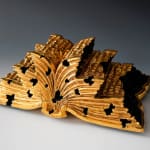Miwa Ryosaku 三輪龍作 b. 1940
H17.2 x W46.9 x D24.8cm
Further images
-
(View a larger image of thumbnail 1
)

-
(View a larger image of thumbnail 2
)

-
(View a larger image of thumbnail 3
)

-
(View a larger image of thumbnail 4
)

-
(View a larger image of thumbnail 5
)

-
(View a larger image of thumbnail 6
)

-
(View a larger image of thumbnail 7
)

-
(View a larger image of thumbnail 8
)

Almost 3 centuries before the Japanese archipelago became an imperial organized state, when the land was known as the land of Wa (or Wakoku by historical Chinese sources), the indisputably famous Shamaness-Ruler Himiko governed a federation of kingdoms known as the Yamatai, spread across the island region during the 3rd century C.E. Who was this famous woman? The cosmic mythos of Himiko and her arcana have been compounded over the centuries in Japan and abroad. She is associated frequently with efficacious objects, such as ritual bronze balls used in the Yayoi period, or bronze mirrors imported from China used frequently in Shamanistic rituals. As such, she is often associated with supernatural arcana, constructing a mythical figure in public imagination.
Miwa Ryosaku articulates this historical fame in his major series of ceramic works “The Scripture of Himiko”. Bathed in gold lustre and a deep black glaze, the Scripture of Himiko explores how time moves around certain figures in history. He is interested in the way female figures across history evolve in the public imagination, effectively transcending their real identities, their time, and context. Here, time becomes a tool that blurs the lines between fiction and reality in the fabric of the human idea of “reality” and “universe”. He expresses this through the compositional fissures and cracks in his ceramic surface: Historical lacunae are an important theme in his work. He affirms that human history is inherently imperfect because of the inability for human mediums to articulate precise iterations of events in time. We are bound by an inherent inability to reproduce events in exact likelihood in our material world: there is no such thing as a complete history of something. Miwa brings this to the viewer’s attention, encouraging us to examine the things we might have missed.
This series marks a major phase in Miwa’s oeuvre. Through the lore behind Himiko’s reputation and imagined mythos, his inquisitions on time, the movements of the universe, and human history has successfully articulated a tripartite concept that looks beyond man-made philosophies. He has developed an artistic process and visual vocabulary that grapples with time through the ceramic medium.







